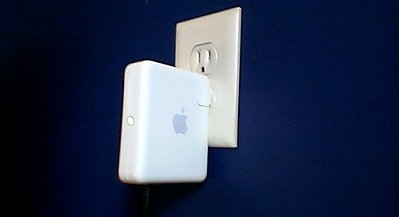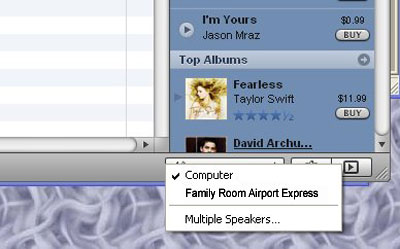- By Dan Veaner
- Business & Technology
 Print
Print  Dr. Digit 'Splains It All
Dr. Digit 'Splains It AllAfter years of being a PC guy I was accused of going over to the dark side when I added a little Macbook to our network. Even before that I had thought that iTunes was the best of the MP3 organizing programs even if you didn't buy songs from the iTunes store. And once I finally succumbed and got an iPod I was blown away by the effortless synergy between that device and the computer. But there was a disconnect between the computer and the place in our house where we actually listen to music.
Enter the Airport Express and AirTunes. Airport Express is a little white box that fits in the palm of your hand. You plug it into the wall and connect a cable from it to your setero, any place in your house. You run a little utility on your computer to set it up. And Presto! iTunes automatically senses the gadget, giving you the option to play your music on the stereo, your computer speakers, or both.

The Airport Express simply plugs into the wall. The cord to
your setereo plugs into the bottom of the device. That is all
the hardware setup you need. The little green light on the
edge of the device tells you it is working. A simple utility
on your PC or Mac walks you through adding the device
to your wireless network.
When it does that you are listening via AirTunes. I don't know why they needed another name for that piece -- AirTunes is so well integrated into iTunes that it doesn't seem like something different. Having a separate name is the most complicated thing about the whole setup. It is gratuitous. But if having an extra name is the worst feature of the whole setup I can live with that.
The Airport Express is actually a little wireless router. Or it can be a network extender (to widen the distance your network can be used). Or it can be used as a print server (so all your computers can share a network. Or it can be used to play your music on your stereo or any powered speakers. Or any combination of these. Since we already have a wireless router I set it up to connect to my existing network, and to play songs on my stereo using an old mini-stereo to RCA cable I already had in the box of random cables under the bed.
I couldn't help but notice that this little device is about a sixth of the size of our wireless router, yet it somehow fits all of those functions into the little box, something our big router doesn't do. You could easily pay the same money for a print server that only works on PCs and does nothing else, possibly making this the one Apple device that is less expensive than PC versions. And since all it has is a plug that goes into a wall socket and it plays music, this thing is truly 'plug and play.'

Once the Airport Express is set up this little menu appears
in iTunes, letting you choose where you want to play your music
Here is the cool thing: after using the Airport Utility to set up the device iTunes magically sensed it and a little drop-down menu appeared in the lower right hand corner of the iTunes window that gives me the choice of outputs. On my system it offers Computer, Family Room Airport Express, and Multiple Speakers. If I set up a second Airport Express with another stereo, it would appear on this menu as well.
I set all of this up using my MacBook, but the Airport Express comes with the setup utility for the PC, so I could have done it on the PC instead. After years of going through the adventure of setting up devices under Windows, I expected there would be more setup to do. But I was shocked when I started up iTunes on the PC my daughter uses and it already knew about the family room stereo. This means that as long as they are on the same network my kids can play their music on the stereo if they want to. It was that automatic -- no setup whatsoever on the other computers.
And here is the other cool thing -- yep there are two cool things! -- if you have an iPod Touch or an iPhone you can download a free utility that turns the device into a remote control for iTunes. Downloading the utility from the iTunes store was effortless, and setting it up was the same. It sensed iTunes on my computer and that was that. Now I can control what plays on the stereo from anywhere in the house using the same interface I was already used to on the iPod. I can choose songs, albums, artists, or playlists, adjust the volume, play and pause from anyplace within range of the wireless network. It can control iTunes on other computers if you want it to, giving our stereo access to the music libraries of everyone in the family. Zero effort, zero learning curve.
And perfect, because you want to adjust the volume from where the stereo is, not where the computer is.
In keeping with the simple, elegant design of the Airport Express, the device has no buttons (unless you count the little reset button -- more of an indentation than a button, really -- that you may never have to use). It has three outlets for the mini-stereo cable, a USB cable for a printer, and an Ethernet outlet that would be used to connect to your cable or DSL modem if you were using it as a router. And a little light so you can tell it is working.
iTunes is free -- all you have to do is download and install it on your PC or Mac. The remote control utility for the iPod Touch or iPhone is also free. You can pick up an Airport Express for about $100 at Best Buy. I found it for less on the Internet, but shipping costs made it more. iTunes' Genius feature -- you pick a song and click the Genius button and it makes a playlist of 25 similar songs -- works even if you are using the remote control utility.
So with a small investment in equipment and almost no investment in setup time we can pretty much junk the old CD player on our stereo. Playing music from iTunes is as simple as picking it from a menu, giving you a huge choice without having to swap out disks or cassettes. Instead of being mired in technological limbo you can be movin' and groovin' to the music you like, exactly where you like it.
----
v4i44




